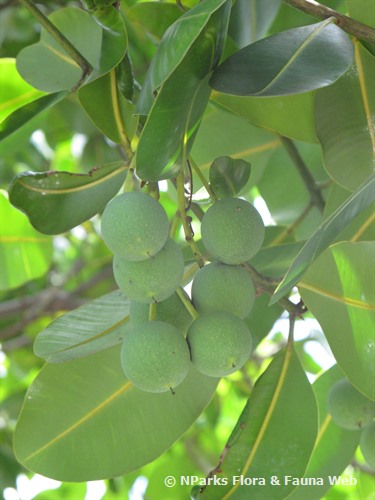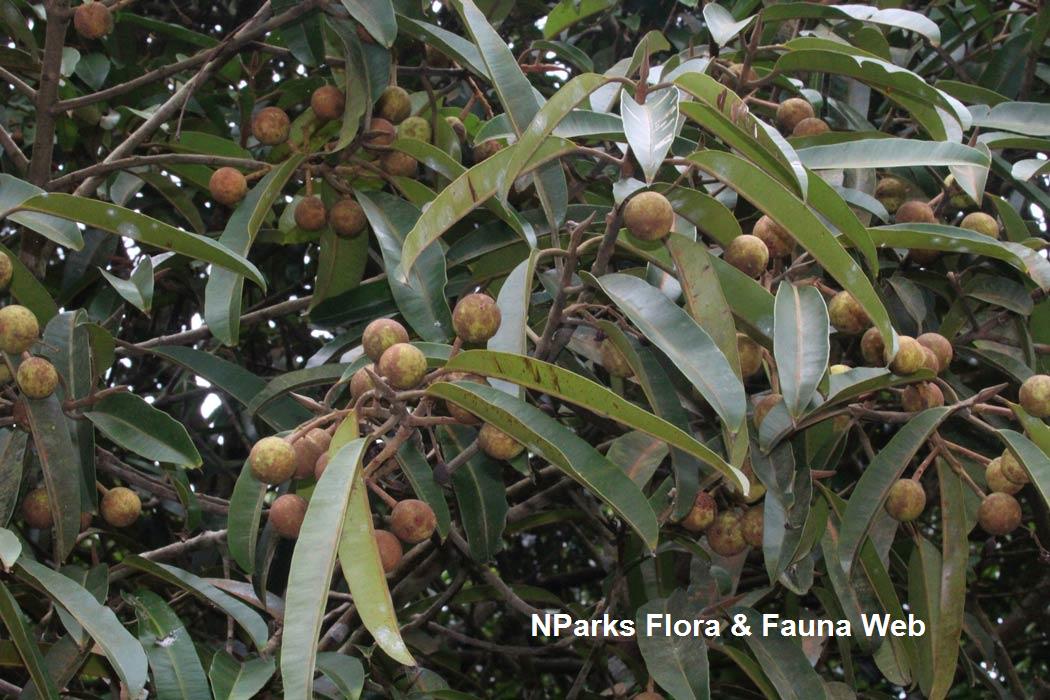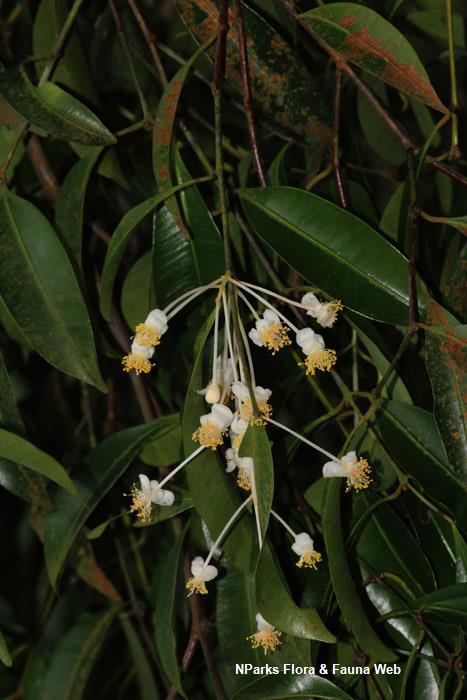
Back
Calophyllum inophyllum L.
| Family Name: | Calophyllaceae |
| Synonyms: | Balsamaria inophyllum Lour., Calophyllum ovatifolium Noronha,, Calophyllum bingator Roxb., Calophyllum blumei Wight, Calophyllum spurium Choisy, Calophyllum wakamatsui Kaneh. |
| Common Name: | Penaga Laut, Bintangor Laut, Borneo Mahogany, Alexandrine Laurel, Alexandrian Laurel, Alexandra Laurel, Indian Laurel, Laurel Wood, Beauty Leaf, Nyamplung, Penaga, Bodek Laut, Paku Achu, Bintangur Bunga, 红厚壳, 琼崖海棠树 |
Calophyllum inophyllum, also known as Penaga Laut, is a tree with glossy oval shaped leaves, sweet-scented white flowers and round green fruits. It provides shade and has many local uses as a source of dye, oil, timber and medicine.
Name
Classifications and Characteristics
| Plant Division | Angiosperms (Flowering Seed Plants) |
|---|---|
| Plant Growth Form | Tree |
| Lifespan (in Singapore) | Perennial |
| Mode of Nutrition | Autotrophic |
| Maximum Height | 30 m |
Biogeography
| Native Distribution | From East Africa to Australia |
|---|---|
| Native Habitat | Terrestrial |
| Preferred Climate Zone | Tropical |
| Local Conservation Status | Native to Singapore (Endangered (EN)) |
Description and Ethnobotany
| Growth Form | It is a tree, up to 30 m tall. It forms low branches and does not have buttress roots. The bark is fissured, grey to brown coloured on the outside and pink on the inside. It produces clear yellow sticky latex when cut. |
|---|---|
| Foliage | The leaves are oval shaped (8 - 15 cm long and 8 cm wide), glossy and are in opposite arrangement. The leaf has rounded or notched tips while the base is cuneate or rounded. Distinct on both surfaces, the lateral veins are dense and uniformly parallel. The petiole is about 1 – 2 cm long. |
| Flowers | The inflorescence is 5 – 10 cm long and occurs at the axis (axillary). Each inflorescence consists of 5 – 15 white flowers with 40 – 250 yellow stamens and globose ovary. The flowers are reportedly sweet-scented but the fragrance only last for a day. |
| Fruit | The fruit is round (2 – 4 cm in diameter) and contains one seed within. The seed is surrounded by a spongy layer which is buoyant in water. The fruit is green and may become brownish when ripe. |
| Habitat | The tree is found in rocky and sandy shores, as well as coastal forest, up to 200 m altitude. It occurs locally in Pulau Seletar and Pulau Ubin. |
| Associated Fauna | The flowers are insect pollinated. The fruits are usually dispersed by sea currents. There are records of bats feeding on the fruits and dispersing the seeds. |
| Cultivation | It is a slow-growing tree that provides shade. |
| Etymology | The genus Calophyllum, in Greek, means beautiful leaf. The specific epithet inophyllum, in Greek, refers to the closely nerved leaves. |
| Ethnobotanical Uses | Food (Herb or Spice) Cultural / Religious: Heritage Tree : There are 3 individuals of Calophyllum inophyllum listed as Heritage Trees in Singapore. They are found all over various parts of Singapore. To find out more about these trees, please visit the Heritage Tree Register. Others: It has many local uses as a source of dye, oil, timber and medicine. The timber is strong and durable, so it is used in bridge construction, boat building and furniture making. In Java, the oil extracted from the seeds is used along with the latex to dye batik cloth. Almost all parts of the plant are used for many medicinal uses due the presence of saponins and hydrocyanic acid. |
Landscaping Features
| Desirable Plant Features | Ornamental Flowers |
|---|---|
| Landscape Uses | Coastal, Suitable for Roadsides |
Fauna, Pollination and Dispersal
| Pollination Method(s) | Biotic (Fauna) |
|---|---|
| Seed or Spore Dispersal | Abiotic, Biotic (Fauna) |
Plant Care and Propagation
| Light Preference | Full Sun |
|---|---|
| Water Preference | Moderate Water |
| Plant Growth Rate | Slow |
| Rootzone Tolerance | Well-Drained Soils, Saline Soils / Salt Spray |
Foliar
| Foliage Retention | Evergreen |
|---|---|
| Mature Foliage Colour(s) | Green |
| Mature Foliage Texture(s) | Smooth, Glossy / Shiny, Leathery |
| Foliar Type | Simple / Unifoliate |
| Foliar Arrangement Along Stem | Spiral |
| Foliar Attachment to Stem | Petiolate |
| Foliar Shape(s) | Non-Palm Foliage (Oval) |
| Foliar Venation | Pinnate / Net |
| Foliar Margin | Entire |
| Foliar Apex - Tip | Rounded |
| Foliar Base | Rounded / Obtuse |
| Leaf Area Index (LAI) for Green Plot Ratio | 3.0 (Tree - Intermediate Canopy) |
Floral (Angiosperm)
| Flower Colour(s) | White |
|---|---|
| Flower Texture(s) | Smooth |
| Flower Grouping | Cluster / Inflorescence |
| Flower Location | Terminal |
| Flower Symmetry | Radial |
| Individual Flower Shape | Tubular |
| Inflorescence Type | Panicle |
| Flowering Habit | Polycarpic |
Fruit, Seed and Spore
| Mature Fruit Colour(s) | Green |
|---|---|
| Mature Fruit Texture(s) | Smooth |
References
| References | Tomlinson, P.B. (2016) The Botany of Mangroves. 2nd Edition. Cambridge University Press, United Kingdom. Byrne, C., Parnell, J.A.N., & Chayamarit, K. (2018). Systematics of the Thai Calophyllaceae and Hypericaceae with comments on the Kielmeyeroidae (Clusiaceae). Thailand Forest Bulletin (Botany), Vol 46 (2), Pg 162 - 216. Keng, H. (1990). The Concise Flora of Singapore: Gymnosperms and Dicotyledons, Singapore: Singapore University Press. George, A.S., Orchard, A.E. & Hewson, H.J. (eds.) (1993)., Flora of Australia, Oceanic islands 2, Vol 50:1-606. Australian Government Publishing Service, Canberra. Gardner, S., Sidisunthorn, P. & Chayamarit, K. (2015). Forest Trees of Southern Thailand. Volume 1 (A–Es). The Forest Herbarium, Bangkok, The Royal Botanic Gardens, Kew. xix + 1–749. Henderson, M.R. & Wyatt-Smith, J. (1956). Calophyllum Linn. Gard. Bull. Singapore 15: 285–375. |
|---|
Image Repository
Others
| Master ID | 1481 |
|---|---|
| Species ID | 2774 |
| Flora Disclaimer | The information in this website has been compiled from reliable sources, such as reference works on medicinal plants. It is not a substitute for medical advice or treatment and NParks does not purport to provide any medical advice. Readers should always consult his/her physician before using or consuming a plant for medicinal purposes. |

_lowres.jpg)
_lowres.jpg)
_lowres.jpg)
_lowres.jpg)
_lowres.jpg)
_lowres.jpg)







_lowres.jpg)
